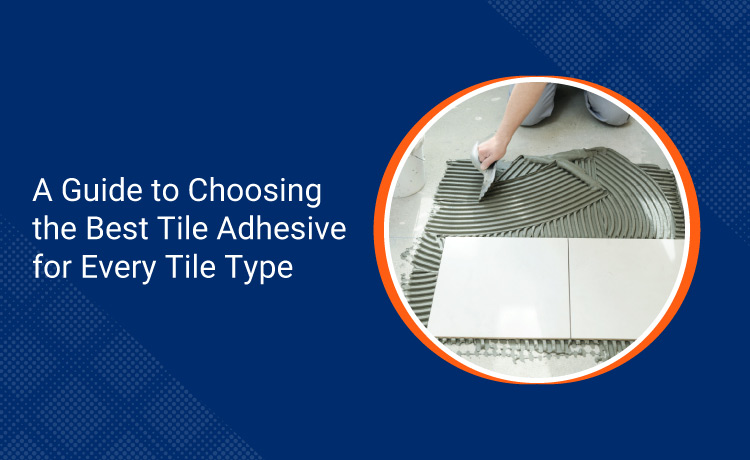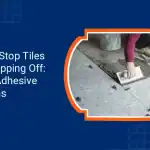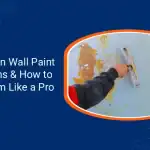 July 28, 2025
July 28, 2025
Choosing the right tile adhesive is crucial for a long-lasting and professional installation. With various tile types and substrates available today, understanding which adhesive works best in specific conditions can help avoid issues, such as tile shifting, cracking, or poor adhesion. This guide provides a detailed breakdown of tile adhesives, their types, properties, and compatibility with various tiles.
Tile adhesives are special types of glue or cement that act as a bonding agent between tile and substrate. They are typically composed of a mixture of cement, sand, polymers, and other various additives. Cement acts as a base material, sand as an aggregator, polymers provide adhesion and moisture resistance, and additives improve the properties of tile adhesive. Their ability to form a strong bond between substrates, tile adhesive significantly prevents tiles from cracking, shifting, and deteriorating over time. Unlike traditional tile adhesion methods, tile adhesives are designed to offer better grip, faster application, and long-term durability.
Below mentioned are different types of tile adhesives:
Cement-based adhesives are widely used to adhere a variety of tiles to their substrate. This adhesive type is typically made from grey cement, sand, and polymers, providing a blend of strength and durability for both indoor and outdoor applications. Cement-based adhesives are typically applied where high strength and resistance to heat, cold, and chemicals are required. They are widely used in fixing the ceramic, vitrified, and natural stone tiles.
Ready-mix adhesive is a pre-prepared, ready-to-use bonding agent. It is known for its convenience, eliminating the time and effort required for mixing the material for application. Ready-mix tile adhesives are made from a blend of cement, polymers, and other additives, making them the best tile adhesive for small projects and DIY applications. They can seamlessly be applied to fix various tile types for indoor applications.
Epoxy-based adhesives are made from thermosetting polymers and are widely used for bonding a range of tile types with high strength and durability. They can seamlessly be used for tiling indoor and outdoor areas, including floors, walls, and roofing. In addition, epoxy-based adhesives are known for bonding with a wide range of substrates, including metals, plastics, glass, and wood, making them versatile adhesives for tiles. In addition to versatility, they offer strong adhesion, high strength, and excellent chemical and heat resistance.
Polymer-modified adhesives are traditional cement-based adhesives enhanced with polymer additives to improve flexibility, bonding strength, and water resistance. These adhesives are ideal for large-format tiles, external facades, or substrates prone to movement. They offer enhanced adhesion even on non-porous surfaces and are suitable for heavy-duty applications, including swimming pools and industrial flooring.
Ceramic tiles are among the most commonly used tiles for walls and light-duty floors. They are lightweight, porous, and easy to cut, making them ideal for DIY installations. Due to their porous nature, ceramic tiles bond well with most adhesives. The ideal adhesive types are cement-based or ready-mixed adhesives. During installation, the surface should be clean and level, and only light pressure is needed to set the tiles properly.
Porcelain tiles are dense, durable, and less porous than ceramic tiles, making them suitable for high-traffic and moisture-prone areas. Their low water absorption requires a stronger adhesive, such as polymer-modified or epoxy-based adhesive, to ensure a secure bond. Installation requires special care due to their weight and hardness, and a strong back-buttering technique is recommended for large tiles.
Glass tiles are non-porous, fragile, and often used for decorative applications like kitchen backsplashes or feature walls. White polymer-modified or epoxy adhesives are best suited to avoid any visible darkening behind the translucent tiles. It is important to handle glass tiles with care and ensure complete adhesive coverage to avoid visible voids.
Natural stone tiles, like marble or granite, are heavy and may vary in porosity. White cement-based or epoxy adhesives are preferred to avoid staining or discoloration. The substrate must be structurally sound to support the stone’s weight, and sealing may be required before installation.
Mosaic tiles, typically mesh-mounted, are small and often used in intricate designs. Ready-mixed or polymer-modified adhesives are ideal. Even adhesive application is essential to prevent seepage through joints.
When selecting a tile adhesive, understanding key performance properties ensures a long-lasting and reliable installation. Below are the features that one should look for:
For reliable and quality options, always prefer to procure tile adhesives from a trusted tile adhesive manufacturer.
Selecting the right tile adhesive depends on multiple factors, starting with tile type and size. Lightweight, porous tiles like ceramic usually work well with cement-based or ready-mixed adhesives. However, denser or larger tiles like porcelain or natural stone require stronger bonding agents such as polymer-modified or epoxy-based adhesives to ensure durability and proper grip. You can explore more about each option in our tile adhesive types and tips guide.
Surface conditions also play a critical role. Smooth or non-porous surfaces like painted drywall or metal require high-adhesion epoxy or polymer-modified adhesives. For porous surfaces such as concrete or screed, standard cement-based adhesives often suffice but may require priming for better bonding.
Indoor vs. outdoor application is another key consideration. Outdoor installations face temperature changes and weather exposure, demanding adhesives with excellent flexibility and weather resistance, such as polymer-modified options. Indoor installations, depending on the space, may allow for simpler adhesive types.
Lastly, consider moisture exposure. Areas like bathrooms, kitchens, and swimming pools need adhesives that offer high water resistance to prevent bond failure due to dampness or water seepage. Epoxy or specially formulated waterproof adhesives are recommended for such applications.
Selecting the right tile adhesive ensures your tiling work’s longevity, strength, and appearance. From understanding adhesive types to evaluating tile-specific needs and installation conditions, each factor plays a crucial role in successful tiling. Whether you are a DIY enthusiast or a professional installer, investing time in choosing the appropriate adhesive pays off in durability and aesthetics. Use this guide as your go-to reference to make informed decisions and achieve a flawless tile installation every time.
Need expert advice or product recommendations? Contact our team for guidance on the best tile adhesive. We are one of the top construction chemical manufacturers in India.

Ashish Gupta is a general manager and civil engineer with over 10 years of experience in the construction chemicals industry. With his technical degree (B.Tech), extensive experience, and chemical shuffling skill, he has been responsible for executing technical solutions in areas like waterproofing, concrete repair, tile adhesive, admixtures, and protective coatings.




